Reclaim the Cinemas!
|
Read more
at in70mm.com The 70mm Newsletter |
| Written by: Thomas Hauerslev | Date: 30.09.2009 |
70mm For All - How to begin the story.... |
|
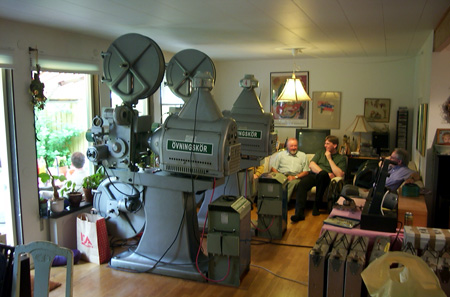 70mm, Friday night and the "Essence of Cinema" in a Swedish living room. Image by Thomas Hauerslev. 70mm, Friday night and the "Essence of Cinema" in a Swedish living room. Image by Thomas Hauerslev.Soon, the 5th Todd-AO Festival will open its doors, and I thought it would be appropriate to look back at past festivals and summarize some thoughts and feelings about "The Cinema". But first a little "overture": Some years ago I was invited to Sweden to attend a screening of “Paint Your Wagon” in 70mm. The meeting was very informal and hosted by a group of ultra-dedicated projectionists and cinema fans. It was the most unusual show I have ever seen. The setup, complete with 70mm projectors, rectifiers and rewind table had been set up in a living room pointing directly out of the huge windows and into the garden. There, a big curved screen had been installed on the lawn, between two trees and garden flowers. Next to the projectors was the kitchen, and refrigerator with plenty of food and beers. Enough to keep the party going for several hours, perhaps even several days. Everything was going perfectly, until the largest rainstorm anyone could remember hit the screening. These people, however, continued with the show sitting outside in authentic cinema chairs, until the last reel. Everyone and everything, screen, seats, speakers, tables and carpets were soaked in rain but morale was high until the last reel ran through the projector in the very early morning. It struck me just how much they love cinema and film. |
More in 70mm reading: Todd-AO Festival Home • 5. Todd-AO Festival • Wilkommen | Welcome • Intro | Festival Images • Festival Flyer (PDF) Festival Archives • Festival Through the Years • Festival Schedule and Archive • More Schauburg Cinerama Festivals in Pictures • Schauburg Cinerama • Best of Todd-AO Festival • Guests | Billboards | Posters Internet link: • Schauburg.de |
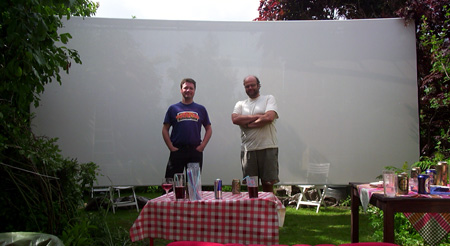 The following morning in the garden cinema, the sun was shining and the curved screen was drying
out. Image by Thomas Hauerslev. The following morning in the garden cinema, the sun was shining and the curved screen was drying
out. Image by Thomas Hauerslev.They could have done it the easy way with a sofa, a VHS tape and a TV screen, but that was definitely not good enough. This Swedish group of people, generally depressed by Hecta-plexes and the closing of old cinemas, they simply set up their own cinema for the weekend, as they believed cinema should be properly presented. “Reclaim the Cinema”, as they called it, and I was delighted to be invited and realized how great and revitalizing this experience was. I think the Swedes captured the "Essence of Cinema". People being together, having a good time, watching a motion picture, sharing something exceptional. Difficult to explain – you have to see this yourself to understand. It inspired me, and it was incredibly refreshing to see enthusiasm for the movies like this - an old film coming alive again for an enthusiastic crowd. Certainly not the average "grindhouse" movie experience. |
|
But, what is it? |
|
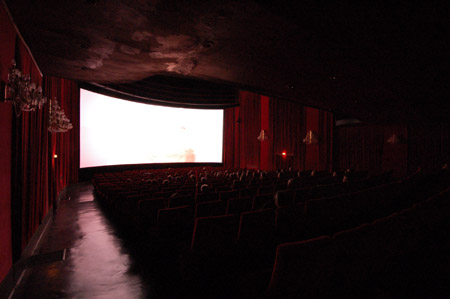 Image
by Thomas Hauerslev Image
by Thomas HauerslevBut what is this "70mm" with people rebuilding their living room to see it? Well, 70mm is the superior cinema experience widely used in the 1960s for big epic movies like "Ben Hur", "Lawrence of Arabia", "2001: A Space Odyssey" and "The Sound of Music". All of these are films which created a lasting impact on people, and for some, this impression has stayed with them since their childhood. 70mm is much sharper compared to current movies. You can compare it with the difference between DVD and BluRay. 70mm is a better product, and considered the ultimate cinema experience. |
|
|
During the 1950s and 60s, there were
several thousand films made, but less than a 100 in 65mm;
later on,
several dozen more were blown up to 70mm. A tiny fraction! Still, those titles
have acquired such an aura
of mystique, like the royalty of cinema, the golden nuggets of films, that
fans are flying in from around the world to see
them. Most of the 70mm films can be bought on DVD and BluRay and seen at home in splendid color and restored close to their former glory. But that is not good enough. You also have to see them in a cinema to fully appreciate the large format. |
|
"Essence of Cinema", say what? |
|
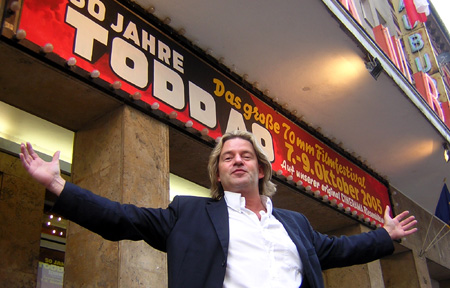 Herbert
Born welcoming you to the Schauburg. Image by Thomas Hauerslev Herbert
Born welcoming you to the Schauburg. Image by Thomas HauerslevCan the "Essence of Cinema" be found in places besides Sweden? Indeed it can, in many places - it is really up to yourself. I have been fortunate to experience it several places myself. Mr. Herbert Born invited me to come to Karlsruhe for his first Todd-AO Festival back in October 2005. Being familiar with 70mm festivals in the magnificent Pictureville cinema in Bradford, I was excited to go and see how Herbert would organize his 70mm film festival. Herbert has worked for 30 years in German movie industry and is a respected member of independent cinema exhibition. He has received several awards for his work in Karlsruhe and recently he served as consultant for the 59th Berlinale 70mm Retrospective. Herbert has a "good nose" and understanding of what the audience likes and how they prefer the “Essence of Cinema” at the Schauburg. It is easy to see his dedication and interest in the big screen. I felt we hit it off very quickly back then and we became "long lost Viking brothers". We share the same childish kind of humour, which makes it very easy to work together. |
|
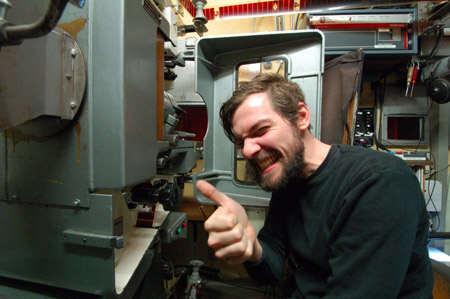 Markus
Vetter approving the image. Image by Thomas Hauerslev Markus
Vetter approving the image. Image by Thomas HauerslevThe Historic Schauburg cinema dates back to 1906 when it was built as a single screen theatre. Nowadays it has 3 screens under the same roof: Schauburg (350 seats), Cinema (former balcony) (150 seats) and off to the side, the Bambi with 61 seats. All three screens have 2K digital projection and naturally all sorts of film and sound formats. The Schauburg is a leading and independent cinema in Germany, and the 70mm weekend is a supplement to wide range of activities already taking place in the cinema. Herbert also runs an open air cinema with 2500 seats and a 24 x 9 meter screen. 2009 season ran from 24 July until 13 September and nearly 33.000 guests came by to enjoy movies "Grand Style" at Schloß Gottesaue about 2 km outside Karlsruhe city centre. Every Saturday and Sunday, the Schauburg features a large breakfast buffet for their guests. The Schauburg is also a popular place to have your wedding pictures taken on the curved staircase. |
|
|
The cliché of the German people – unparalleled quality and done by the book, raised my expectations. Just think Gerd Fröbe’s character in "Those Magnificent Men in Their Flying Machines" where he does everything by the book, because “There iz nozing a German offizer cannot do”. Naturally I felt I was in for something special, and I was not disappointed. For a casual cinema goer like me, and with a background in projection, I looked forward to 3 days of quality projection. I got everything I could wish for and much more. The staff of the Schauburg has a very open and relaxed attitude and at the same time show incredible attention to detail in projection and care of the audience. The festival turned out to be a wonderful experience, with posters, German beer, ultra sharp pictures on a curved screen, 6-track magnetic sound, a fabulous cinema, very nice staff and feeling of being very welcome. |
|
Going to Karlsruhe |
|
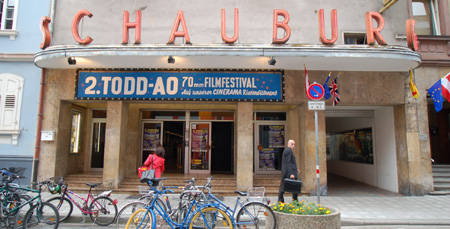 The
front including a flowerpot. Image by Thomas Hauerslev The
front including a flowerpot. Image by Thomas HauerslevKarlsruhe is in Germany, and Germany is in Europe. If you live in Europe it is very easy to reach the Todd-AO Festival by plane, train or automobile. Many guests live close to the festival and use car to get there, but also public transportation is easy. If you live abroad, flying in is the "choice" of transportation. Frankfurt airport has arrivals from most corners of the world but also Stuttgart and Baden Baden airports can be used. Personally I have travelled by air and by train from Copenhagen. The past two years I have used the train, being tired of airport hassle and waiting. By plane the voyage to Karlsruhe takes about 4-5 hours via Frankfurt and connecting onwards by ICE train. By overnight train the journey takes 13 hours, but you have the benefit of a luxurious 1st class CityNightLine sleeping compartment and arrive refreshed from a good night sleep on the platform on Karlsruhe Hbf (The central station) the following morning. Very convenient and CO2 friendly. |
|
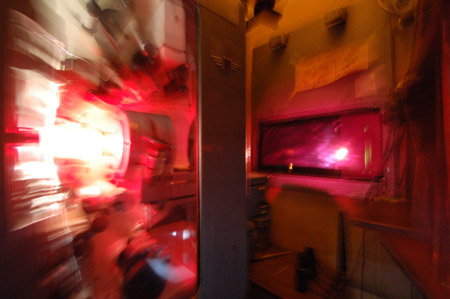 Image
by Thomas Hauerslev Image
by Thomas HauerslevKarlsruhe has one of Europe’s most extensive networks of trams ("Trolleys", in the US). In fact it is integrated with the German Rail network which makes it very easy to reach far beyond Karlsruhe city center by direct tram. A very unique system. The city center is a nice long and wide pedestrian street where the trams are running in the middle of the street and on the central square – cars are not allowed. Karlsruhe extends far out in all directions and there is even a large in-land port, which is connected to the Rhine River. In theory it would be possible to sail to the Todd-AO Festival, but I have not yet heard about anyone arriving by boat! The official festival hotel is the "Hotel Novotel Karlsruhe City" very close to the cinema. My preferred rooms are facing the main street with a nice view to the trams going by from early morning to midnight - I love them, as we don't have trams any more in Denmark. I always ask for a room with a view to the trams. My friend Wolfram, does the opposite. He wants a peaceful room on the other side the hotel. Hotel staff is very friendly, and you can park your car in the basement. The hotel bar is open when the Schauburg is closed and often 70mm friends gather in the bar for a final beer or a sandwich. |
|
Community and understanding your audience |
|
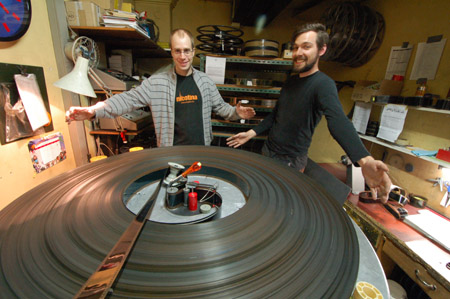 Projection
team Vincent Koch and Markus Vetter embracing the "Dersu Uzala" 70mm print.
Image by Thomas Hauerslev Projection
team Vincent Koch and Markus Vetter embracing the "Dersu Uzala" 70mm print.
Image by Thomas HauerslevThe Todd-AO Festival attracts a large and diverse audience, mainly from Germany, of course. But the festival has grown into an annual international event with guests from everywhere including France, Holland, Czech Republic, Slovak Republic, Canada, Denmark, Sweden, Austria, Switzerland, Spain, Portugal, United Kingdom and USA. The core audience - which is almost all mature males - is very dedicated to 70mm and some are signing in months in advance before making their pilgrimage to Karlsruhe to see these large format films. They possess a huge knowledge of film and formats and can debate for hours and hours about how films should be presented, and not least how they USED to be presented in the golden days of 70mm presentation. |
|
|
But, everyone is most welcome:
you don't need to have "70mm" as your hobby, know anything about it or have any special qualifications. Just come in and see what the greatest show is. The door is open. Some have even gone the extra "mile" and really promote 70mm, trying to keep the flame alive a little longer. That includes Johan Wolthuis who is promoting 70mm through his International 70mm Publishers (and his latest book project, "Digital & 65mm") and of course Brian Guckian of the 65/70mm Workshop. Personally I have given a couple of lectures and "The Early Days of Todd-AO" and about "Film Formats". Another friend of the Schauburg is Wolfram Hannemann who is always the right man on the spot with very good introductions to the films. It is amazing what he can dig out - funny and interesting facts about the films. Something to take home for everyone. |
|
Catering - no, we cannot have people starving |
|
 Image
by Thomas Hauerslev Image
by Thomas HauerslevOne of the problems watching films all day long during a weekend of 70mm films is the lack of food. Obviously you have to eat from time to time, so you could "theoretically" leave the cinema and miss a film or two. But, if you travel to Karlsruhe to see films, that is not really the best solution - to miss a film. In Bradford during the Widescreen Weekend in March, the time issue has been discussed for many years. The breaks between films are usually very short in order to have a as much material as possible to show the audience during the weekend. The audience appreciates a lot of material, but they also ask for longer breaks to be able to eat and network. It's always a difficult balancing act. Compared to Bradford, and the "maze" of National Media Museum departments, which cannot always work together, it is much easier for Herbert to adapt to the need of the audience. Being an independent cinema owner who controls everything, he has a natural feeling for this, and offers the audience "only" 4 films a day, and some suitable breaks between films. |
|
|
On top of that, and included in the festival pass, he serves a full
breakfast in the Schauburg foyer 9 o'clock Saturday and Sunday. In the
afternoon he makes sure that the audience is well taken care of with a snack
between the films. Of course the audience can buy beers and chocolate, but
the snack is included in the festival pass price. I think the audience
appreciates it, because it creates a relaxed atmosphere, as they don't have to leave the cinema
to get lunch or dinner. They can stay, talk and enjoy food, beverages and film. Oh
yes, I forgot the local beer. Hoepfner Brew sponsors the Friday
night get-together. I have tested and
can recommend the beer - very good. |
|
List of Films |
|
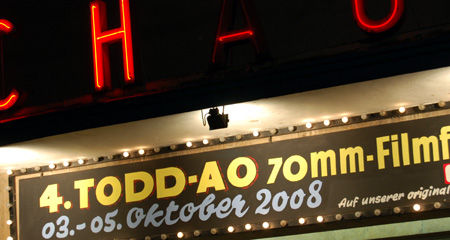 Image
by Thomas Hauerslev Image
by Thomas HauerslevFive years of 70mm festivals in Karlsruhe has produced an impressive "track record" of 70mm films. More than 40 titles in their original 70mm road-shown splendor. "The Agony and the Ecstasy", "Airport", "Around the World in 80 Days" (Cinestage), "Baraka", “Ben Hur”, "The Bible...in the beginning", "Cleopatra", "Doctor Dolittle", “El Cid”, "Exodus", "Far and Away", "Grand Prix", “Hauptmann Florian von der Mühle”, "Hello, Dolly!", "Ice Station Zebra", "Imperial Venus", “Khartoum”, "The King and I", "Der Kongress Amuesiert Sich", "The Last Valley", "Lawrence of Arabia", "Mutiny on the Bounty", "My Fair Lady", "Pathfinder", "Patton", “Play Time", "Ryan’s Daughter", "Taras Bulba", "Song of Norway", "The Sound of Music", "South Pacific", "Spartacus", "STAR!", "Terminator 2", "Those Magnificent Men in Their Flying Machines", "Titanic", "2001: A Space Odyssey", "Uncle Toms Cabin", "The Wall", "Where Eagles Dare", "The Wild Bunch" Short films: "As Good as it Gets“, "A Year Along The Abandoned Road", "Fanny´s Wedding", "Fortress of Peace", "Motion", "Shellarama", "Sky over Holland", "Tanakh Bibelen Al-Quran" and "Tour Eiffel" |
|
Films dubbed into German |
|
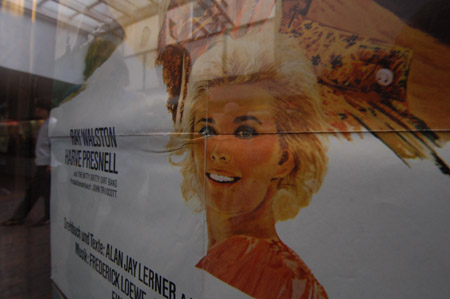 Image
by Thomas Hauerslev Image
by Thomas HauerslevWhen I talk to people and recommend to go and see 70mm films in Bradford or Karlsruhe, most people reacts very strongly against going to Karlsruhe, because the films "are in German". I say "yes, it's a German festival, what do you expect?", "Yes but they are dubbed!". And, agreed, they are dubbed, and wouldn't it be nice if they were in English? But hey, they are not. They are vintage 70mm prints and so rare, that in many cases you will not find any other 70mm prints in the original version. So the alternative is a DVD in the small toy cinema at home. And why go "plastic" when you can have the "reel" deal? But I see a German dub from the positive side. I have seen many of the films before, so it's like re-visiting an old friend, only this time I have the opportunity of learning something about another culture, which is very close to my own, and yet very different. In Denmark films are always in the original version and with subtitles, but Germany has a long tradition of dubbing. |
|
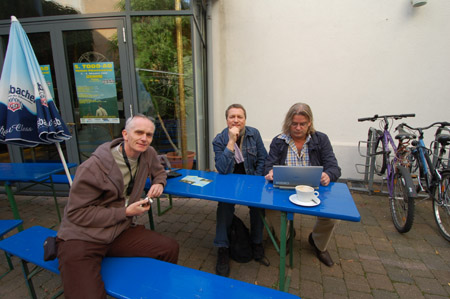 Duncan
McGregor, Thomas Hauerslev and Herbert Born during a short 70mm break.
Festival images are uploaded during festival. Image by August Hauerslev Duncan
McGregor, Thomas Hauerslev and Herbert Born during a short 70mm break.
Festival images are uploaded during festival. Image by August HauerslevSince I have seen some of the films before and know the story, dialogue and feel, the language issue doesn't really bother me that much. The big image is still there, regardless of the language. In fact I think I can say, that I actually forget it a little bit it is in German if I have seen the movie before. Maybe not entirely, but I stick to the image and visuals. I admit it is very difficult to follow an old MCS 70 "classic" in German, but rather in German than no film at all. A few years ago, I was very impressed by the German version of "My Fair Lady". It impressed me how close the voices were to the English originals. Great art to do Rex Harrison or Richard Burton. I would not want to miss a rare title in 70mm just because it is in German. What is the alternative? Not seeing them at all? Not a trade off I'm willing to take. |
|
The Presentations and Showmanship |
|
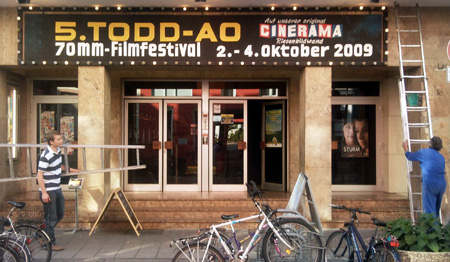 Image
by Herbert Born Image
by Herbert BornIt does puzzle me a bit why those 70mm films are still so popular that people, including myself, are traveling in from near and far to see them. Most of them were not even very good, many were flops, even KINGs of flops. Some bombed so spectacularly at the cinema, that they were never heard of again. Granted, a dozen of them were very, very good movies and still hold up today, because they were good stories, very well produced, had good actors and directors. But many were really bad. The sole common denominator was the presentation format: 70mm with 6-track stereo. So, what is the attraction? Why do people like me remember (- and I wasn't even born when they premiered, but have caught up later!). What's going on here? Is this nuts or what? I'll tell you what it is: It's a different experience to watch these old films, and something unlike anything you can see anywhere else in cinemas today. They have wonderful analogue magnetic sound which is very pleasing to the ear. It's not particularly loud, it just sounds good, has depth and fidelity. Some will argue it sounds much better than "state of the art" modern sound. |
|
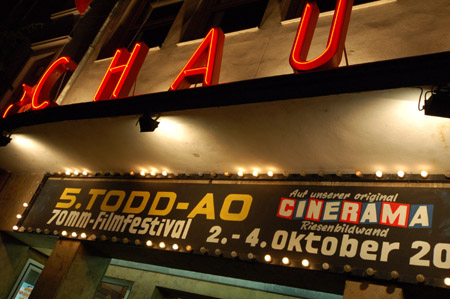 Image
by Thomas Hauerslev Image
by Thomas HauerslevToday the original films are very old and faded, which means there is often no color left in the prints, except the red dyes, which sometimes turns pink. In fact old 70mm prints have the whole color spectrum: red, pink, brown, Technicolor and full color. They also have scratches and many splices from a lot of use more than 40 years ago. But they are still unbelievably SHARP and have eye popping production quality - they are BIG EPIC movies. And that makes all the difference in the world to see on the curved screen. It's so extraordinary, and different from a "normal" cinema, that it has to be seen to be understood. There is no "digital" trickery involved with classic 70mm. It is still done with analogue technology developed in the 1950s. Projectors are still the same as they were many years ago, but the lenses are brand new, and no expenses are spared to get the best to please the audience. Getting the best includes presenting something not seen in cinemas for 30-40 years: Ultra Panavision 70, an anamorphic projection technology utilized for applied to only 9 films. Very few cinemas could actually show full width Ultra Panavision 70, even with the proper lenses. The Schauburg can show it, and with brand new Schneider lenses at that. And everything is always in perfect focus thanks to the two house projectionists: Markus Vetter and Vincent Kock. |
|
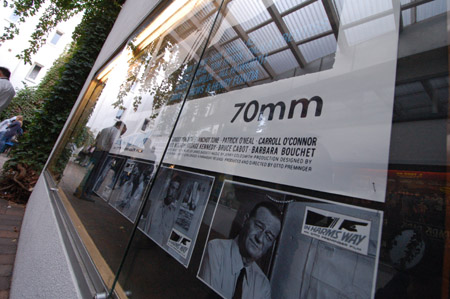 Image
by Thomas Hauerslev Image
by Thomas HauerslevIn Schauburg, 70mm is shown on a curved screen which adds to the excitement, because that how it was done when the films came out 50-55 years ago. The screen is 17 meters wide, and the depth of the curve is about 3 meters. That adds a sense of depth, when the actors move from one side of the screen to another. Enhancing a good performance inside the cinema is a lobby and facade decorated with movie posters. It is a lost art form to "make up" the cinema. Let the audience know what you are showing. Schauburg's decoration is second to none, with vintage movie posters and stills. On the facade outside is a large 7 meter sign specially painted every year to let the audience know something special is happening. Looks very good with revolving 60w lamps around it. The audience is also given a free 80 page booklet, or weekend program in German and English, with specially written articles and movie information. A nice souvenir to take home. |
|
Special Guests |
|
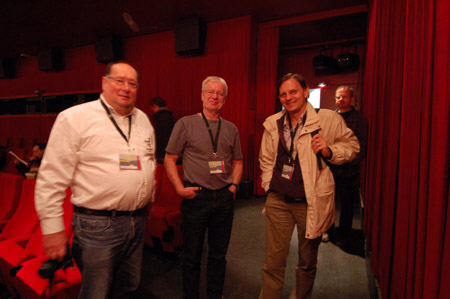 Francois
Carrin, Orla Nielsen and Jean-Rene Failliot Friday 2 October 2009. Image by
Thomas Hauerslev Francois
Carrin, Orla Nielsen and Jean-Rene Failliot Friday 2 October 2009. Image by
Thomas HauerslevOne of the pleasing events are the film maker visitors. Schauburg has welcomed Jean Rene Failliot (Arane Laboratory, Paris, France), Gerhard Fromm, Dieter Gaebler & Heinz Hoelsher of MCS 70 process history. Todd-AO History has been celebrated in the presence of Walter Siegmund, who developed the Todd-AO process together with Brian O'Brien and many others. Cinematographer Bob Gaffney was also celebrated a few years ago, by showing a selection of his short films - all done in large format. |
|
The Importance of a Festival |
|
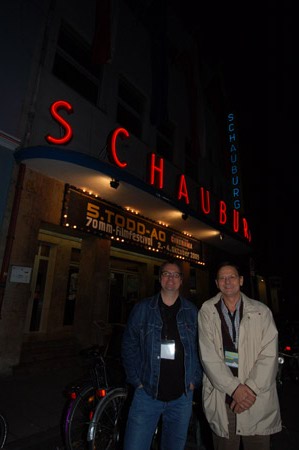 Thomas
Hauerslev and Jean-Rene Failliot. Image by Orla Nielsen Thomas
Hauerslev and Jean-Rene Failliot. Image by Orla NielsenAs I began this story in Sweden I will end it in Germany, by saying that I think Herbert Born and his staff have also captured the "Essence of Cinema" for me. Bringing people together, having a good time, watching the screen, sharing something exceptional. Schauburg is the "Disneyland of 70mm" - it cannot be seen anywhere else like this. I think it is great that someone is doing this for people and for 70mm. It's important to keep the awareness of 70mm and the cinema experience alive. It is not a financial goldmine, rather the opposite. For the John Doe, the movie consumer, 70mm is a footnote, and largely forgotten by everyone, although a small group of people is doing what they can to support "their local 70mm theatre". |
|
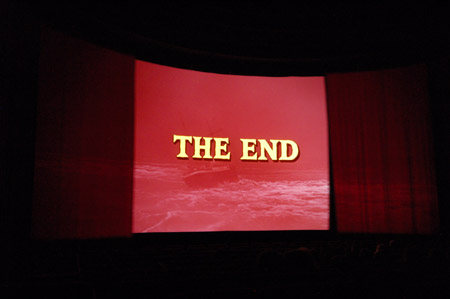 Image
by Thomas Hauerslev Image
by Thomas Hauerslev70mm is good in a cinema like Schauburg with a design and proportions supporting 70mm films. To me, the Schauburg is a chance to see classic films again in the best environment - and it's really worth the effort to go on a long weekend to see movies. I heartily recommend it. This is really the best place to see 70mm, and not only for it's technical virtues. There is much more to see. Let’s hope the Todd-AO Festival will continue for many years. |
|
|
Go: back
- top - back issues
- news index Updated 21-01-24 |
|
